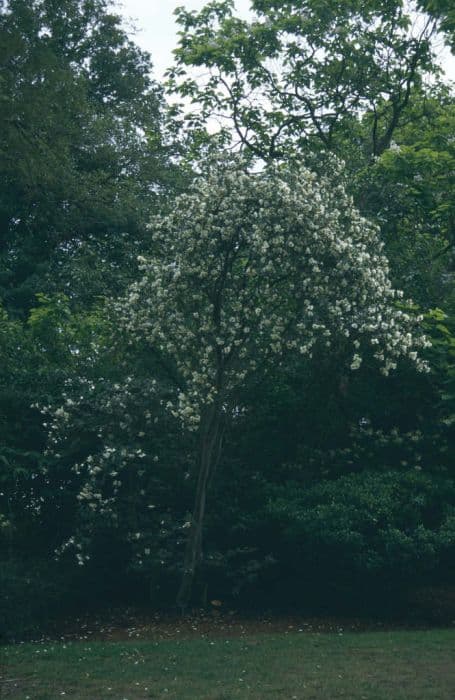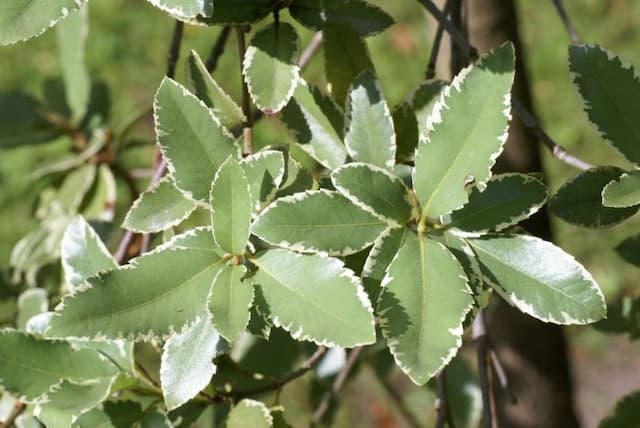Nymansay Eucryphia Eucryphia × nymansensis 'Nymansay'

ABOUT
Eucryphia × nymansensis 'Nymansay', commonly known as 'Nymansay' Eucryphia, is a decorative and visually appealing plant that is a hybrid known for its ornamental qualities. It bears a lush foliage that is typically glossy and dark green, providing a rich, dense background for its other striking features. During the blooming season, 'Nymansay' Eucryphia becomes even more striking. It produces large, cup-shaped flowers that are generally white, which stand out against the dark leaves. These blossoms are often richly fragrant, attracting pollinators such as bees and butterflies to the garden. The texture of the leaves may be described as leathery, and they often have a serrated edge, providing a somewhat textured feel both visually and to the touch. The overall form of 'Nymansay' Eucryphia is usually well-structured, often described as being upright and tidy, making it a popular choice for gardeners who wish to create a formal or semi-formal look in their landscapes. The branching pattern is regular, with branches extending outward to provide a well-balanced appearance. When not in bloom, its foliage alone makes it a valuable addition to any garden, offering a year-round deep green to the palette. The sturdy stems and branches of the 'Nymansay' Eucryphia support its foliage and flowers well, contributing to the overall robust appearance of the plant. As an ornamental plant, it is often chosen for its striking contrast of white flowers against dark foliage and for its pleasant structure that suits a variety of garden designs. Whether planted as a specimen or used in a hedge or border, 'Nymansay' Eucryphia adds undeniable charm and an air of sophistication to the garden space.
About this plant
 Names
NamesFamily
Cunoniaceae
Synonyms
Nymansay Eucryphia, Nyman's Eucryphia
Common names
Eucryphia × nymansensis 'Nymansay'.
 Toxicity
ToxicityTo humans
The plant Eucryphia × nymansensis 'Nymansay', commonly known as Nymansay, does not have a well-documented profile of toxicity to humans. There is limited information available on its effects when ingested or otherwise. However, like any plant that is not typically recognized as edible, it is advisable to avoid ingestion to prevent the possibility of gastrointestinal discomfort or allergic reactions. If any part of the plant is ingested and symptoms occur, it is recommended to consult a healthcare professional.
To pets
Similar to the information available for human toxicity, there is limited specific information regarding the toxicity of the Nymansay plant to pets. As a general precaution, it is best to prevent pets from ingesting plants that are not known to be safe. If a pet ingests Nymansay and exhibits signs of illness, such as vomiting, diarrhea, or unusual behavior, it is important to seek veterinary care promptly.
 Characteristics
CharacteristicsLife cycle
Perennials
Foliage type
Evergreen
Color of leaves
Green
Flower color
White
Height
20 feet (6 meters)
Spread
10 feet (3 meters)
Plant type
Shrub
Hardiness zones
7
Native area
Hybrid
Benefits
 General Benefits
General Benefits- Ornamental Value: Eucryphia × nymansensis 'Nymansay', also known as Nymans Eucryphia, is a hybrid plant prized for its attractive appearance, especially its abundant white flowers that bloom in late summer.
- Habitat Support: It provides nectar for pollinators such as bees, butterflies, and other beneficial insects, contributing to local biodiversity.
- Shade Provision: Nymans Eucryphia can grow to a substantial size, offering shade in gardens and parks, which can help reduce local temperatures and provide relief on hot days.
- Windbreak: This plant can serve as a windbreak, protecting smaller plants and reducing wind erosion in gardens and landscaped areas.
- Privacy Screen: Due to its size and dense foliage, it is often used as a privacy screen or hedge in residential and public spaces.
- Seasonal Interest: Adds year-round interest to gardens with its evergreen leaves, and particularly in the late summer when it flowers.
- Soil Erosion Control: The root system of Nymans Eucryphia helps to prevent soil erosion by stabilizing the soil, which is beneficial for sloped gardens and landscapes.
 Medical Properties
Medical PropertiesThis plant is not used for medical purposes.
 Air-purifying Qualities
Air-purifying QualitiesThis plant is not specifically known for air purifying qualities.
 Other Uses
Other Uses- Eucryphia × nymansensis 'Nymansay', commonly known as Nymans Eucryphia, can be used as a natural dye for textiles, thanks to the pigments found in its bark and flowers.
- The wood of Nymans Eucryphia is sometimes utilized in fine woodworking projects for ornamental pieces, due to its moderate hardness and fine grain.
- Nymans Eucryphia can be incorporated into a sensory garden because the flowers have a subtle fragrance and the leaves offer tactile stimulation.
- Flower photographers and enthusiasts may cultivate Nymans Eucryphia as a subject for photography, to capture the beauty of its blooms which are especially photogenic.
- The dense foliage can serve as a privacy screen or windbreak in landscaping, creating a natural barrier in both domestic and commercial settings.
- Nymans Eucryphia is sometimes used as a living sculpture in topiary gardens, where its growth habit allows it to be shaped into various forms.
- Its blossoms are a source of nectar for bees and other pollinators, thus supporting local biodiversity and benefiting nearby fruit and vegetable crops.
- Horticultural therapy programs may use planting and caring for Nymans Eucryphia as a form of relaxation and mental wellness activity for participants.
- Educational institutions might plant Nymans Eucryphia for botany studies, offering students a chance to learn about hybrid plant species and their characteristics.
- Some people use the fallen petals of Nymans Eucryphia for crafting, such as in the creation of natural confetti or for inclusion in eco-friendly soaps and candles.
Interesting Facts
 Feng Shui
Feng ShuiThe Eucryphia is not used in Feng Shui practice.
 Zodiac Sign Compitability
Zodiac Sign CompitabilityThe Eucryphia is not used in astrology practice.
 Plant Symbolism
Plant Symbolism- Resilience: Eucryphia × nymansensis 'Nymansay', also known as 'Nymansay', is known for its robustness and ability to thrive in various conditions, representing the ability to withstand adversity and bounce back.
- Rarity: As a hybrid plant with specific origins, 'Nymansay' symbolizes uniqueness and the beauty of rare finds in nature.
- Adaptability: The capacity of this plant to adapt to different environments signifies flexibility and the power of adjusting to changing circumstances.
- Purity: With its white flowers, 'Nymansay' is often associated with purity and innocence, commonly attributed to the simple and clean appearance of white blooms.
 Water
WaterThe Tasmanian leatherwood requires regular watering to maintain moist soil, particularly during dry seasons. Water thoroughly once a week, providing approximately 1 to 1.5 gallons per watering session for an established plant, ensuring that water penetrates deeply into the soil to reach the roots. During hot, dry periods, the frequency may need to increase to twice a week. It's important not to let the soil dry out completely, but also avoid waterlogging as it can lead to root rot. Always check the top inch of soil for dryness before watering again.
 Light
LightTasmanian leatherwood thrives in a location with full sun to partial shade. The ideal spot is one that receives morning sunlight and some afternoon shade, especially in hotter climates. Too much intense afternoon sun can be harmful, so it's important to strike a balance for the plant's health.
 Temperature
TemperatureTasmanian leatherwood prefers a temperate climate and can typically withstand temperatures down to about 20 degrees Fahrenheit. It is important to protect the plant from harsh winter winds and frost, which could damage it. The ideal temperature range for growing this plant is between 50 and 70 degrees Fahrenheit, which encourages healthy growth and flowering.
 Pruning
PruningPrune Tasmanian leatherwood after flowering to maintain shape and encourage bushier growth. Pruning too late in the season can remove next year's flower buds, so the best time is immediately after the blooming period ends, typically in late summer or early fall. Remove any dead or diseased branches, and thin out overcrowded areas to improve air circulation; this is typically done once a year.
 Cleaning
CleaningAs needed
 Soil
SoilTasmanian Leatherwood flourishes best in well-draining, slightly acidic soil with a pH between 5.5 and 6.5. A mix of peat, coarse sand, and loamy soil is ideal for maintaining the appropriate moisture and nutrient levels for optimal growth.
 Repotting
RepottingTasmanian Leatherwood rarely needs repotting; it should only be repotted if the plant has outgrown its container, typically every 3 to 5 years, to refresh the soil and promote health.
 Humidity & Misting
Humidity & MistingTasmanian Leatherwood thrives in moderate to high humidity levels, ideally between 40% to 60%, to mimic its natural habitat.
 Suitable locations
Suitable locationsIndoor
Bright, indirect light; consistent moisture; regular feeding.
Outdoor
Plant in partial shade, shelter from strong winds, well-drained soil.
Hardiness zone
9-11 USDA
 Life cycle
Life cycleEucryphia × nymansensis 'Nymansay', commonly known as Nymansay Eucryphia, begins its life cycle as a seed which germinates in moist, well-drained soil with ample sunlight exposure. Seedlings emerge and grow into saplings, establishing a root system and producing juvenile leaves. As the plant matures, it develops into a small to medium-sized evergreen tree with a sturdy trunk, and its leaves mature into the glossy, dark green foliage characteristic of the adult plant. The Nymansay Eucryphia enters its reproductive stage producing fragrant white flowers during late summer, which are pollinated by insects, leading to the production of woody seed capsules. These capsules eventually release seeds, completing the cycle. The plant reaches maturity and can live for several decades, continuing to grow and reproduce annually.
 Propogation
PropogationPropogation time
Late winter-early spring
Propogation: Eucryphia × nymansensis 'Nymansay', commonly known as Nymans Eucryphia, is most effectively propagated by semi-hardwood cuttings. This technique involves taking cuttings of about 4 to 6 inches (10 to 15 centimeters) in length from the current year's growth in late summer or early autumn. The bottom leaves are stripped off, and the cutting base is treated with a rooting hormone to encourage root development before planting in a well-draining potting mix. The cuttings are then positioned in a sheltered spot with indirect sunlight and kept consistently moist but not waterlogged. It is often beneficial to cover the cuttings with a plastic bag or place them in a propagator to maintain high humidity. Rooting usually takes several weeks, and once rooted, the cutting can be re-potted into individual pots and grown on before transplanting into the garden.



